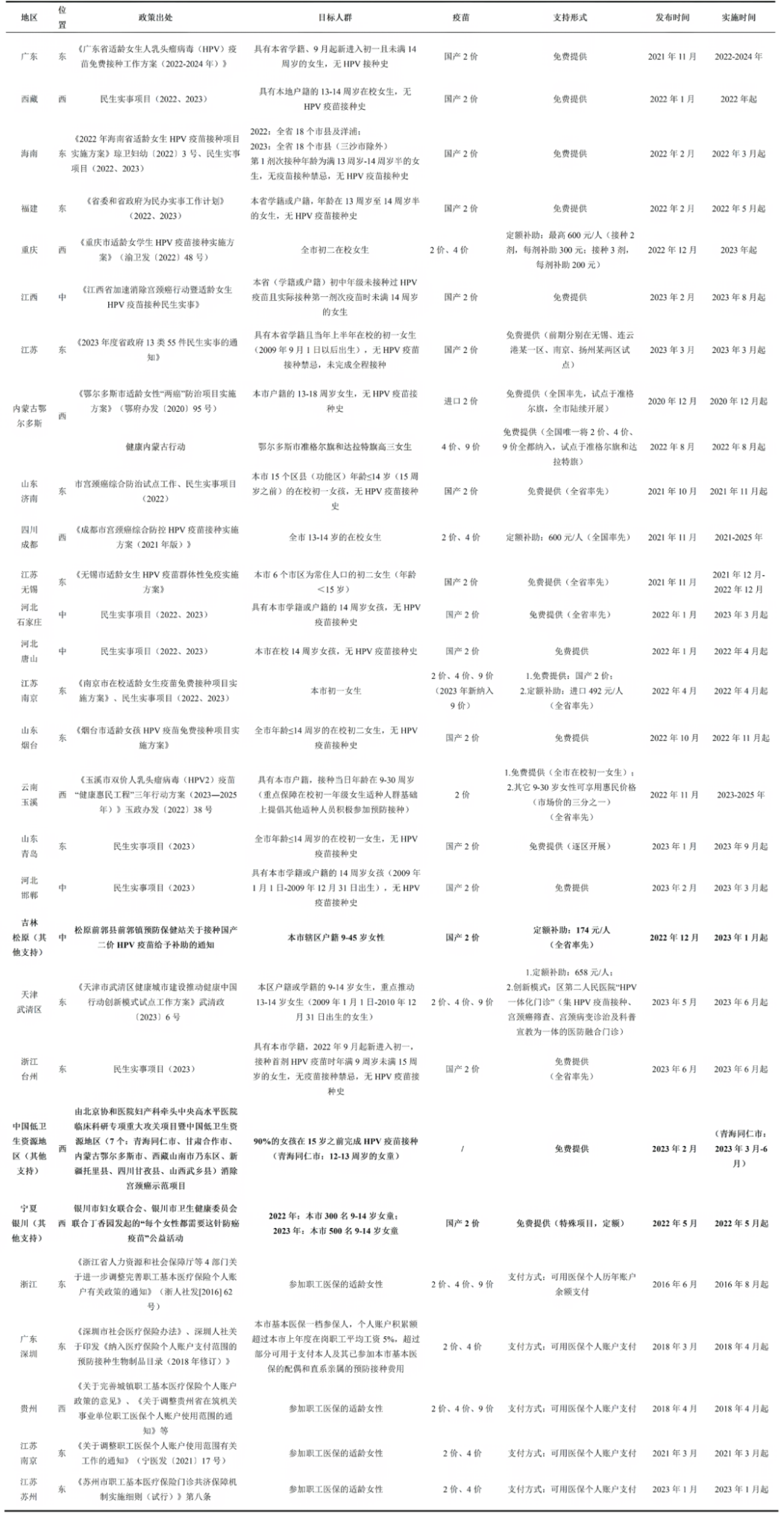Journal Article Recommendation
01
Human papillomavirus (HPV) type 16 and type 18 antibody concentrations after a single dose of bivalent HPV vaccine in girls aged 9–14 years compared with three doses of quadrivalent HPV vaccine in women aged 18–25 years in Costa Rica (PRIMAVERA): a non-randomised, open-label, immunobridging, non-inferiority trial
This study, published in The Lancet Infectious Diseases, aimed to evaluate whether the immunogenicity of a single dose of the AS04-adjuvanted bivalent HPV vaccine (Cervarix) administered to girls aged 9–14 years is non-inferior to that of a three-dose schedule of the quadrivalent HPV vaccine (Gardasil-4) administered to women aged 18–25 years. Conducted as a non-randomized, open-label, non-inferiority immunobridging trial, the study took place in Guanacaste Province, Costa Rica, between April 1 and August 16, 2019. It enrolled 620 healthy girls (receiving one dose of the bivalent vaccine) and 620 healthy women (receiving three doses of the quadrivalent vaccine at months 0, 2, and 6).
The primary endpoint was the geometric mean concentration (GMC) of serum antibodies specific to HPV-16 and HPV-18 at 36 months, measured using a validated virus-like particle-based ELISA. Non-inferiority was defined as the lower bound of the 96% confidence interval (CI) for the GMC ratio (girls/women) being ≥0.67 for both HPV-16 and HPV-18. The HPV-16 analysis included 905 participants who were seronegative for HPV-16 at enrollment (539 girls, 366 women), while the HPV-18 analysis included 896 seronegative participants (523 girls, 373 women).
At 36 months, the GMC for HPV-16 in the single-dose bivalent vaccine group was 21.4 IU/mL (95% CI 19.7–23.3), significantly lower than the 42.9 IU/mL (95% CI 38.9–47.3) observed in the three-dose quadrivalent group, yielding a GMC ratio of 0.50 (96% CI 0.44–0.57). In contrast, the GMC for HPV-18 in the single-dose bivalent group was 8.0 IU/mL (95% CI 7.4–8.8), which was non-inferior to the 7.2 IU/mL seen in the three-dose quadrivalent group, with a GMC ratio of 1.11 (96% CI 0.95–1.29). At 36 months, the seropositivity rate for HPV-16 was 99.8% in the single-dose group and 100% in the three-dose group, while the HPV-18 seropositivity rate was higher in the single-dose group than in the three-dose group (98.9% vs. 96.0%; p=0.0065). Additionally, there were two serious adverse events reported in the girls and thirteen in the women, none of which were deemed related to HPV vaccination.
The study concludes that while a single dose of the bivalent HPV vaccine met the non-inferiority criterion for HPV-18 immunogenicity, it did not meet this threshold for HPV-16. Despite near-universal seropositivity and antibody levels comparable to those observed in previous efficacy studies, the current evidence is insufficient to support changes to existing vaccination schedules. Further research assessing vaccine efficacy using persistent HPV infection as an endpoint is necessary to provide more direct evidence for the potential implementation of a single-dose regimen.
https://doi.org/10.1016/S1473-3099(25)00284-1
02
Immune persistence of a single dose of 23-valent pneumococcal polysaccharide vaccine: A 6-year follow-up
This study, published in Human Vaccines & Immunotherapeutics, aimed to evaluate the long-term immunogenicity of a single dose of the 23-valent pneumococcal polysaccharide vaccine (PPV23) six years after administration, providing evidence to inform vaccination strategies. It was a follow-up (Phase IV) study based on a prior Phase III randomized, double-blind, active-controlled clinical trial conducted in September 2021 in Kaifeng County, Henan Province, targeting individuals aged 2 years and older. The follow-up adopted an open-label design and enrolled 600 participants aged 2 years and above (at the time of vaccination) in a 3:1 ratio from the original trial, all of whom had previously received either the investigational vaccine or the control vaccine. Immunogenicity was assessed by measuring serotype-specific capsular IgG antibody concentrations against 23 pneumococcal serotypes using enzyme-linked immunosorbent assay (ELISA). A total of 598 participants were included in the final analysis.
The results showed that 28 days after vaccination, IgG geometric mean concentrations (GMCs) for all serotypes increased significantly (ranging from 1.5–46.2 μg/mL in the vaccine group and 1.6–43.2 μg/mL in the control group), with the highest GMC observed for serotype 14 and the lowest for serotype 3. At six years post-vaccination, most serotype-specific IgG GMCs remained significantly elevated compared to pre-vaccination levels (1.1–1.8 fold increase in the vaccine group, 1.1–1.7 fold in the control group), although they had declined markedly from the levels observed at 28 days post-vaccination. Age-stratified analysis showed similar geometric mean increases (GMIs) across age groups compared to baseline. Among children, GMIs ranged from 1.0–2.3 (1.0–2.0 in the control group); among adults, 1.1–2.1 (0.8–1.8 in the control group); and among older adults, 1.2–2.8 (1.3–2.3 in the control group).
The study concluded that a single dose of PPV23 provides sustained immune protection for up to six years. However, given the observed decline in antibody levels over time, it is recommended that elderly individuals and those with underlying health conditions consider receiving a booster dose five years after the initial vaccination to maintain protection against invasive pneumococcal disease.
*This study was funded by Sinovac Biotech Co., Ltd.
https://doi.org/10.1080/21645515.2025.2517489
03
HPV vaccination and malignancy risks beyond cervical cancer: A retrospective global cohort study
This study, published in Pharmacological Research, aimed to evaluate the potential protective effect of HPV vaccination against non-cervical malignancies using large-scale real-world data. Conducted as a global, multicenter, retrospective cohort study, it utilized electronic health records (EHR) from the TriNetX network and included individuals aged 8 years and older who had received the HPV vaccine. Vaccinated individuals were matched 1:1 with unvaccinated controls using propensity score matching (PSM). All participants had at least one follow-up visit within 1 to 12 months after their initial cancer screening. Primary outcomes included the incidence of malignancies in the head and neck, digestive, anogenital, neurological, and hematological systems, as well as all-cause mortality. Kaplan-Meier survival analysis and Cox proportional hazards models were used to evaluate hazard ratios (HRs) over 8-year and 20-year follow-up periods.
The results revealed several significant findings: (1) The risk of hypopharyngeal and laryngeal cancers was markedly reduced, with vaccinated individuals having only one-fifth the risk compared to unvaccinated individuals (8-year HR = 0.19; 95% CI: 0.057–0.631; p = 0.0025; 20-year HR = 0.227; 95% CI: 0.067–0.764; p = 0.0092). (2) A significant reduction in leukemia incidence was observed among the vaccinated group (8-year HR = 0.461; p = 0.0035; 20-year HR = 0.443; p = 0.0019). (3) All-cause mortality decreased by approximately 46% in the vaccinated group (8-year HR = 0.543; 20-year HR = 0.536). However, the study did not find significant protective effects of HPV vaccination against rectal cancer, anal cancer, oral cancer, or prostate cancer.
The study concluded that HPV vaccination not only prevents cervical cancer but also significantly reduces the risk of other cancers such as laryngeal cancer and leukemia, contributing to substantial survival benefits. These findings provide evidence supporting the expansion of HPV vaccine indications. Further research is needed to explore the oncogenic mechanisms of HPV and consider extending vaccination strategies to broader populations.
https://doi.org/10.1016/j.phrs.2025.107851
04
Maternal Vaccination as an Integral Part of Life-Course Immunization: A Scoping Review of Uptake, Barriers, Facilitators, and Vaccine Hesitancy for Antenatal Vaccination in Ireland
This study, published in Vaccines, systematically assessed the current status and key determinants of maternal vaccination uptake in Ireland using the 5A framework—Access, Affordability, Awareness, Acceptance, and Activation—proposed by Thomson and colleagues. The research team conducted a comprehensive search across nine databases and ultimately included 12 relevant studies, which were categorized and synthesized according to the 5A framework. Thematic analysis was used to extract critical influencing factors.
The findings revealed that maternal vaccination coverage in Ireland ranged from 31–67% for the Tdap vaccine and 40–55.1% for the influenza vaccine. Multiple studies indicated that higher maternal age (over 30 years), higher socioeconomic status, and higher levels of education were significantly associated with increased vaccination uptake. Importantly, healthcare provider recommendation emerged as the most influential factor promoting vaccine acceptance. Two studies identified general practitioner (GP) recommendation as the most common reason for maternal vaccination, although discrepancies were noted in how consistently healthcare providers offered such recommendations, often due to concerns about vaccine safety.
One study found that among GPs who did not recommend pertussis vaccination during pregnancy, 81% expressed safety concerns. In contrast, only 29% of those who did recommend the vaccine shared such concerns. These concerns primarily stemmed from a perceived lack of safety data on vaccination during pregnancy and fears of potential long-term complications. Pregnant women themselves were mainly worried about potential harm to the fetus and demonstrated limited awareness of vaccine-preventable diseases. While Ireland’s national immunization policy ensures the affordability of vaccines, challenges remain in terms of service accessibility.
The study concluded that potential strategies to improve maternal vaccination coverage include (1) integrating vaccination reminders into routine antenatal care visits, (2) enhancing healthcare provider training to increase their willingness and ability to recommend vaccines, and (3) implementing targeted public health education campaigns with effective use of social media to build pregnant women’s trust and understanding of vaccine benefits and safety.
https://doi.org/10.3390/vaccines13060557
05
Newborn RSV immunization rates and reasons compared to family COVID-19 and influenza immunization status
This study, published in BMC Pediatrics, aimed to explore the motivations behind parental decision-making regarding respiratory syncytial virus (RSV) immunization for newborns in an urban population primarily composed of Medicaid recipients and to examine how these decisions relate to family uptake of COVID-19 and influenza vaccines. Conducted during the 2023–2024 RSV season at Temple University Hospital and its affiliated pediatric clinics in Philadelphia, the study employed purposive sampling to conduct in-depth semi-structured interviews with 25 parents or primary caregivers who had chosen RSV immunization for their newborns. All participants were among the first to receive the long-acting monoclonal antibody Beyfortus® (nirsevimab) following its market release. Using a grounded theory approach, the researchers conducted iterative coding to identify themes related to vaccine perception and acceptance.
The study found that 68% of participants expressed complete trust in healthcare professionals and prioritized safety and efficacy when making immunization decisions. Key motivators for RSV immunization included personal or family experience with RSV infection (40%), a strong desire to protect their newborns (36%), and pediatrician recommendations (16%). In contrast, COVID-19 vaccine hesitancy was primarily driven by doubts about vaccine efficacy (64%) and concerns about side effects (18%). Social media and political influences played a relatively minor role (12%). Parents generally lacked access to stable, trustworthy sources of vaccine information and often relied on non-professional internet searches. Notably, many parents misunderstood the concept of vaccine efficacy, equating it with complete immunity rather than its scientific definition of reducing disease severity.
The study highlighted that parental acceptance of RSV immunization was largely driven by a protective instinct and awareness of the disease, whereas hesitancy toward the COVID-19 vaccine stemmed from doubts about efficacy and a lack of understanding of the purpose of immunization. While healthcare provider recommendations were found to be influential, parents lacked consistent, reliable sources of immunization information. The study recommended enhancing public education on vaccine effectiveness and consolidating access to credible information to improve overall childhood immunization rates and help mitigate existing vaccine hesitancy.
https://doi.org/10.1186/s12887-025-05889-x
06
Impact of Revised Vaccination Recommendations for Mature Infants on Premature Infants’ Vaccination Compliance in Germany
This study, published in Infectious Diseases and Therapy, examined the impact of simplified vaccination schedules for full-term infants on vaccine uptake among preterm infants in Germany. In August 2015 and August 2020, the German Standing Committee on Vaccination (STIKO) revised the recommended immunization schedules for full-term infants, reducing the pneumococcal conjugate vaccine (PCV) and hexavalent vaccine (HEXA*) schedules from 3+1 to 2+1 doses. However, STIKO continued to recommend the 3+1 schedule for preterm infants due to their higher vulnerability. Using data from the German health insurance claims database (InGef), this retrospective analysis included 10,337 preterm infants (ICD-10-GM codes P07.2/P07.3) and 187,789 full-term infants born in 2013, 2016, 2018, and 2020, with a 24-month follow-up period. The primary outcome was the full vaccination rate (FVR) for both vaccines before and after policy changes in both populations.
The results showed that among full-term infants, HEXA vaccine uptake increased from 73.8% in 2018 (under the 3+1 schedule) to 81.3% in 2020 (under the 2+1 schedule). However, among preterm infants, HEXA vaccine coverage declined significantly from 71.0% in 2018 to 57.8% in 2020. Similarly, PCV vaccination coverage among full-term infants rose from 68.3% in 2013 (3+1) to 75.6% in 2016 (2+1), whereas coverage in preterm infants declined from 65.4% in 2013 to 40.8% in 2016. Notably, despite STIKO’s continued recommendation of the 3+1 schedule for preterm infants, only 52.5% of them had completed the PCV series by 2020—still below the 65.4% rate seen in 2013. The study did not observe a correlation between reduced vaccine coverage and an increase in disease incidence. It was suggested that the decline may stem from parental or physician misconceptions that the revised schedules apply uniformly to all infants, or from immunization systems failing to distinguish the specific needs of preterm infants.
The study concluded that although STIKO has consistently recommended a 3+1 schedule for PCV and HEXA vaccines in preterm infants, their full vaccination rates have declined significantly following schedule simplification for full-term infants. This highlights an urgent need to strengthen the implementation of STIKO guidelines. Comprehensive measures—including improved immunization management systems, enhanced training for healthcare providers, and more robust parental education—are essential to ensure adequate immunization protection for this high-risk population.
*HEXA: a combined six-in-one vaccine that protects against poliomyelitis, diphtheria, tetanus, pertussis, Haemophilus influenzae type b, and hepatitis B.
https://doi.org/10.1007/s40121-025-01173-8
Content Editor: Tianyi Deng
Page Editor: Ruitong Li





